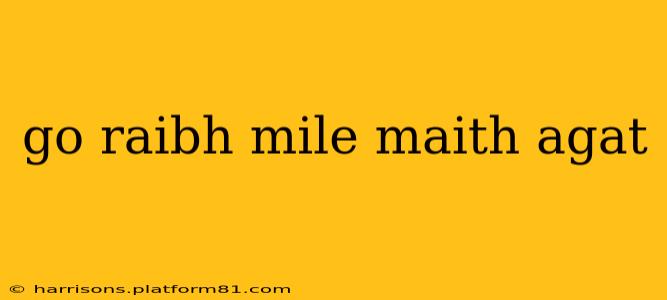This phrase, "Go raibh míle maith agat," is Irish Gaelic. It's a very polite and formal way of saying "Thank you very much." Let's delve a little deeper into its meaning and usage.
Go raibh míle maith agat: A Deep Dive into Irish Gratitude
This expression is a beautiful example of the richness of the Irish language. Let's break it down:
-
Go: This is a particle that indicates a wish or a prayer. Think of it as similar to "May" in English, as in "May you have a good day."
-
raibh: This is the past subjunctive form of the verb "to be." It's used here to create a polite and somewhat formal tone.
-
míle: This means "a thousand."
-
maith: This means "good."
-
agat: This means "with you," or more accurately in this context, "to you."
Therefore, a literal translation would be something like, "May a thousand goods be with you," or "May you have a thousand good things." This clearly expresses a much deeper sentiment of gratitude than a simple "thank you." The "thousand" emphasizes the abundance of appreciation felt.
Why is this phrase so powerful?
The beauty of "Go raibh míle maith agat" lies not just in its translation, but in its cultural context. It reflects the Irish emphasis on politeness, grace, and expressing gratitude deeply. It’s not just a quick acknowledgment of a favor; it's a heartfelt wish for continued well-being.
When to use "Go raibh míle maith agat"?
This phrase is suitable for expressing sincere gratitude in a variety of situations, including:
- Formal occasions: It's perfectly appropriate for thanking someone for a significant favor or act of kindness in a formal setting.
- Expressions of deep gratitude: When simple "thank you" feels insufficient, this phrase conveys the depth of your appreciation.
- Showing respect: Using this phrase demonstrates respect and politeness towards the person you're thanking.
Other ways to say "thank you" in Irish Gaelic:
While "Go raibh míle maith agat" is a powerful option, there are other ways to express gratitude in Irish Gaelic, depending on the context and level of formality:
- Go raibh maith agat: This is a simpler version, meaning "Thank you."
- Buíochas leat: This translates to "Thank you." It's a more common and less formal alternative.
- A bhuíochas leat: This is a more emphatic version of "Buíochas leat," adding a bit more feeling.
In conclusion, "Go raibh míle maith agat" is more than just a translation of "thank you very much." It's a window into Irish culture and a powerful expression of deep, heartfelt gratitude. Learning to use this phrase correctly adds a layer of richness and authenticity to your interactions with Irish speakers.
